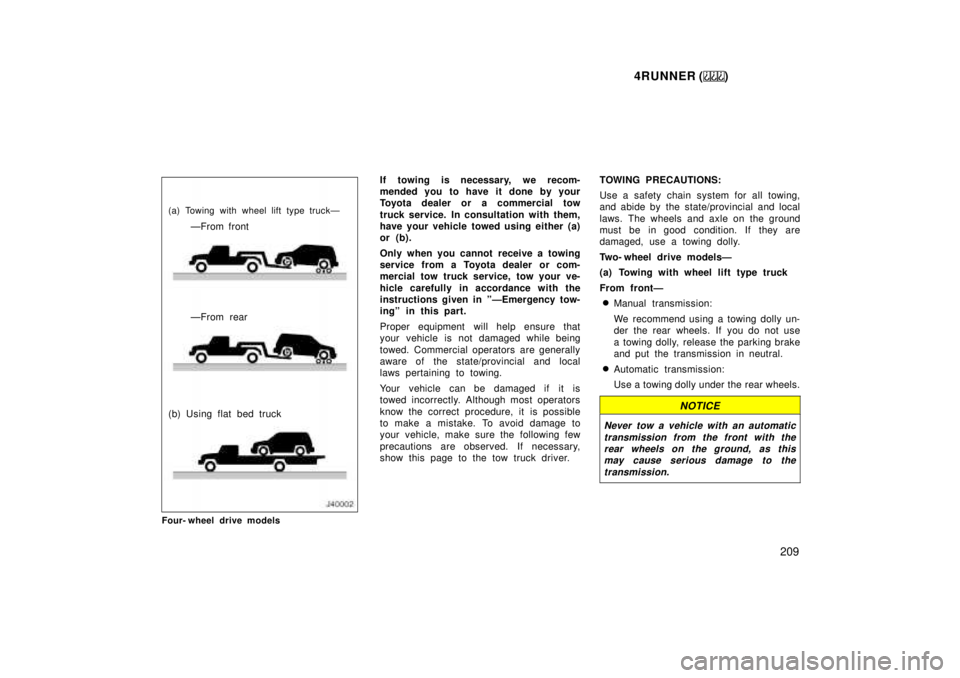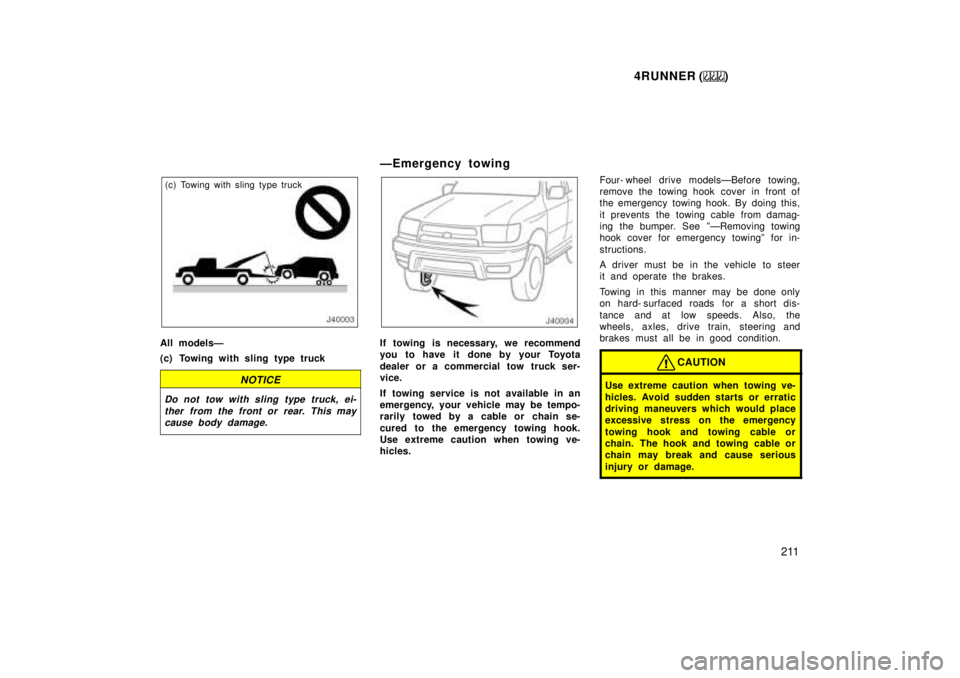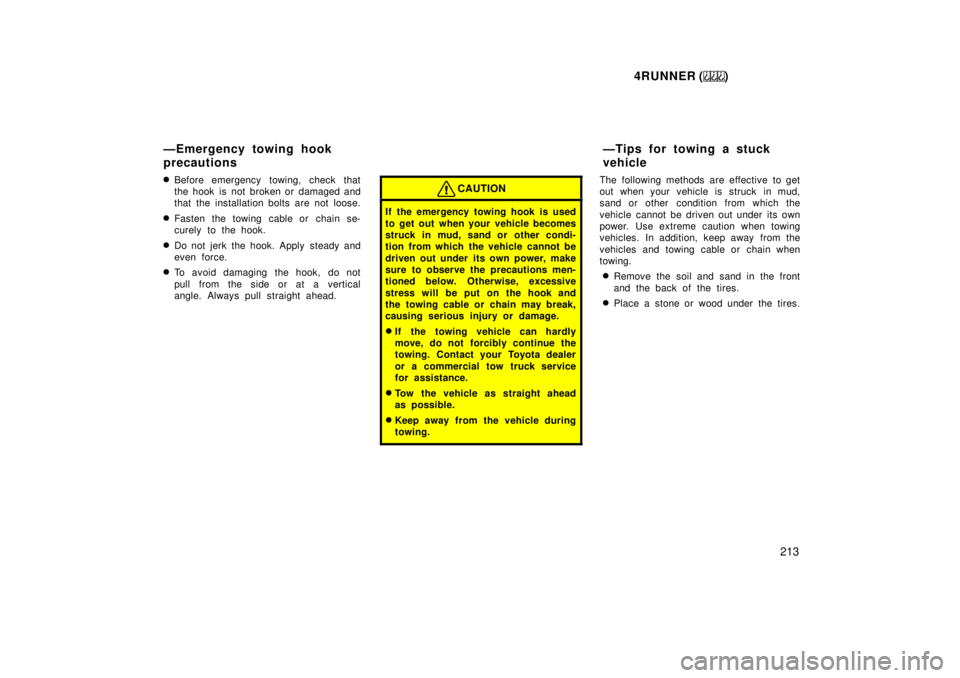Page 209 of 268

4RUNNER ()209
(a) Towing with wheel lift type truckÐÐFrom front
ÐFrom rear
(b) Using flat bed truck
Four- wheel drive models If towing is necessary, we recom-
mended you to have it done by your
Toyota dealer or a commercial tow
truck service. In consultation with them,
have your vehicle towed using either (a)
or (b).
Only when you cannot receive a towing
service from a Toyota dealer or com-
mercial tow truck service, tow your ve-
hicle carefully in accordance with the
instructions given in ºÐEmergency tow-
ingº in this part.
Proper equipment will help ensure that
your vehicle is not damaged while being
towed. Commercial operators are generally
aware of the state/provincial and local
laws pertaining to towing.
Your vehicle can be damaged if it is
towed incorrectly. Although most operators
know the correct procedure, it is possible
to make a mistake. To avoid damage to
your vehicle, make sure the following few
precautions are observed. If necessary,
show this page to the tow truck driver.
TOWING PRECAUTIONS:
Use a safety chain system for all towing,
and abide by the state/provincial and local
laws. The wheels and axle on the ground
must be in good condition. If they are
damaged, use a towing dolly.
Two- wheel drive modelsÐ
(a) Towing with wheel lift type truck
From frontÐ
� Manual transmission:
We recommend using a towing dolly un-
der the rear wheels. If you do not use
a towing dolly, release the parking brake
and put the transmission in neutral.
� Automatic transmission:
Use a towing dolly under the rear wheels.
NOTICE
Never tow a vehicle with an automatic
transmission from the front with therear wheels on the ground, as this may cause serious damage to the
transmission.
Page 211 of 268

4RUNNER ()211
(c) Towing with sling type truck
All modelsÐ
(c) Towing with sling type truck
NOTICE
Do not tow with sling type truck, ei- ther from the front or rear. This maycause body damage.
ÐEmergency towing
If towing is necessary, we recommend
you to have it done by your Toyota
dealer or a commercial tow truck ser-
vice.
If towing service is not available in an
emergency, your vehicle may be tempo-
rarily towed by a cable or chain se-
cured to the emergency towing hook.
Use extreme caution when towing ve-
hicles. Four- wheel drive modelsÐBefore towing,
remove the towing hook cover in front of
the emergency towing hook. By doing this,
it prevents the towing cable from damag-
ing the bumper. See ºÐRemoving towing
hook cover for emergency towingº for in-
structions.
A driver must be in the vehicle to steer
it and operate the brakes.
Towing in this manner may be done only
on hard- surfaced roads for a short dis-
tance and at low speeds. Also, the
wheels, axles, drive train, steering and
brakes must all be in good condition.
CAUTION
Use extreme caution when towing ve-
hicles. Avoid sudden starts or erratic
driving maneuvers which would place
excessive stress on the emergency
towing hook and towing cable or
chain. The hook and towing cable or
chain may break and cause serious
injury or damage.
Page 212 of 268
4RUNNER ()
212
NOTICE
Use only a cable or chain specifically intended for use in towing vehicles.Securely fasten the cable or chain tothe towing hook provided.
Before towing, release the parking brake
and put the transmission in neutral (manu-
al) or ºNº (automatic) and the transfer in
ºH2º (four- wheel drive models). The key
must be in ºACCº (engine off) or ºONº
(engine running).
CAUTION
If the engine is not running, the pow-
er assist for the brakes and steering
will not work so steering and braking
will be much harder than usual.
Towing hook
cover
Clip
Removing clip
Installing clip 1. Use a phillips-
head screwdriver and re-
move the clip.
2. Unhook the towing hook cover.
ÐRemoving towing hook cover
for emergency towing
(four- wheel drive models)
Page 213 of 268

4RUNNER ()213
�
Before emergency towing, check that
the hook is not broken or damaged and
that the installation bolts are not loose.
� Fasten the towing cable or chain se-
curely to the hook.
� Do not jerk the hook. Apply steady and
even force.
� To avoid damaging the hook, do not
pull from the side or at a vertical
angle. Always pull straight ahead.
CAUTION
If the emergency towing hook is used
to get out when your vehicle becomes
struck in mud, sand or other condi-
tion from which the vehicle cannot be
driven out under its own power, make
sure to observe the precautions men-
tioned below. Otherwise, excessive
stress will be put on the hook and
the towing cable or chain may break,
causing serious injury or damage. �If the towing vehicle can hardly
move, do not forcibly continue the
towing. Contact your Toyota dealer
or a commercial tow truck service
for assistance.
� Tow the vehicle as straight ahead
as possible.
� Keep away from the vehicle during
towing.
The following methods are effective to get
out when your vehicle is struck in mud,
sand or other condition from which the
vehicle cannot be driven out under its own
power. Use extreme caution when towing
vehicles. In addition, keep away from the
vehicles and towing cable or chain when
towing.
� Remove the soil and sand in the front
and the back of the tires.
� Place a stone or wood under the tires.
ÐEmergency towing hook
precautions
Ð Tip s fo r to win g a st u ck
vehicle